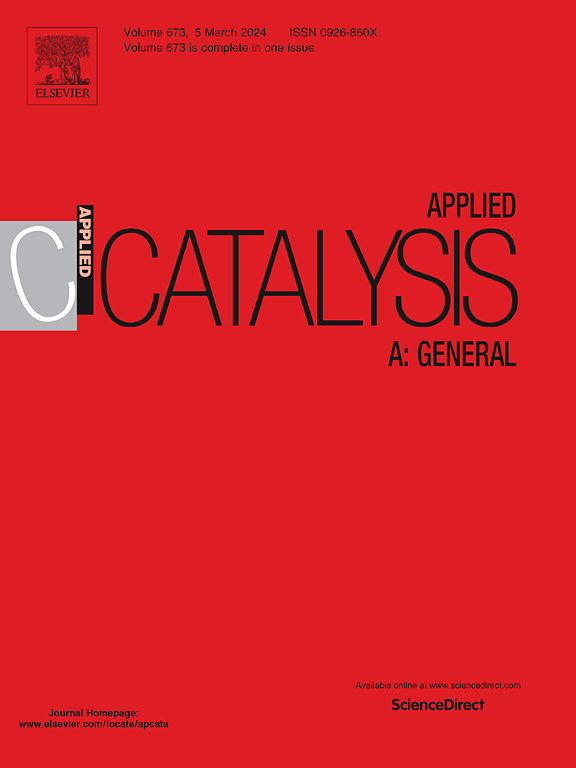MOF-derived carbon-supported cobalt oxide catalysts with strong electronic oxide-carbon interactions for selective catalytic oxidation of C-H bonds
IF 4.8
2区 化学
Q2 CHEMISTRY, PHYSICAL
引用次数: 0
Abstract
Carbon-supported metal oxide catalysts are highly important for heterogeneous catalysis. In addition to exciting charge transfer and regulating the electronic structure of the active metal component, the interfacial interaction between carbon and oxide can also affect the adsorption/desorption of reactants. Thus, the construction of electronic metal-support interactions for fine-tuning the performance and selectivity of the resulting heterogeneous catalysts has received widespread attention in recent years. Herein, a one-pot strategy is used to fabricate a novel porous carbon-metal oxide catalyst by pyrolyzing a Co-SiO2@Co-MOF-74 composite precursor and etching the SiO2 template. Notably, tunable carbon channels with encapsulated cobalt clusters are formed in situ, and a defined strong electronic interaction between them is demonstrated. Owing to the strong interfacial interaction in this unique microreactor, cobalt oxide clusters can be anchored in a highly dispersed state to provide hierarchical carbon pores and promote charge transfer from the carbon channel to the metal sites. This process leads to enhanced reactant adsorption and activation, thereby promoting the catalytic activity of C-H bond oxidation in toluene. Under optimized conditions, Co-MSC-2 afforded 28 % conversion of toluene and 96 % selectivity for benzaldehyde, and the catalyst maintained remarkable stability. Our research proposes a new type of strong electronic oxide-carbon interaction for developing effective catalysts for C-H bond oxidation.
mof衍生的碳负载钴氧化物催化剂,具有强电子氧化物-碳相互作用,用于选择性催化氧化碳氢键
碳载金属氧化物催化剂在多相催化中具有重要的应用价值。除了激发电荷转移和调节活性金属组分的电子结构外,碳与氧化物之间的界面相互作用也会影响反应物的吸附/解吸。因此,构建电子金属支撑相互作用来微调所得到的非均相催化剂的性能和选择性近年来受到了广泛的关注。本文采用一锅策略,通过热解Co-SiO2@Co-MOF-74复合前驱体并蚀刻SiO2模板来制备新型多孔碳-金属氧化物催化剂。值得注意的是,具有封装钴簇的可调谐碳通道在原位形成,并且它们之间存在明确的强电子相互作用。由于这种独特的微反应器中强大的界面相互作用,氧化钴团簇可以被锚定在一个高度分散的状态,以提供分层的碳孔,并促进电荷从碳通道转移到金属位点。该过程增强了反应物的吸附和活化,从而提高了甲苯中C-H键氧化的催化活性。在优化条件下,Co-MSC-2对甲苯的转化率为28% %,对苯甲醛的选择性为96% %,催化剂保持了较好的稳定性。我们的研究提出了一种新型的强电子氧化-碳相互作用,用于开发有效的C-H键氧化催化剂。
本文章由计算机程序翻译,如有差异,请以英文原文为准。
求助全文
约1分钟内获得全文
求助全文
来源期刊

Applied Catalysis A: General
化学-环境科学
CiteScore
9.00
自引率
5.50%
发文量
415
审稿时长
24 days
期刊介绍:
Applied Catalysis A: General publishes original papers on all aspects of catalysis of basic and practical interest to chemical scientists in both industrial and academic fields, with an emphasis onnew understanding of catalysts and catalytic reactions, new catalytic materials, new techniques, and new processes, especially those that have potential practical implications.
Papers that report results of a thorough study or optimization of systems or processes that are well understood, widely studied, or minor variations of known ones are discouraged. Authors should include statements in a separate section "Justification for Publication" of how the manuscript fits the scope of the journal in the cover letter to the editors. Submissions without such justification will be rejected without review.
 求助内容:
求助内容: 应助结果提醒方式:
应助结果提醒方式:


